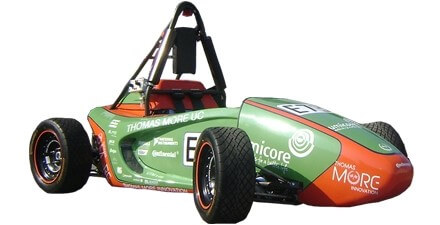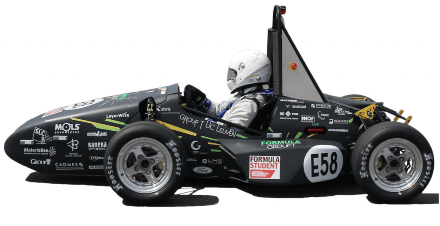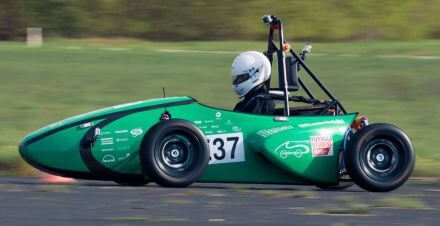Our History
15 years and counting...
Before Formula Electric Belgium (FEB) was founded, 2 Belgian racing teams were competing against each other, Formula Group T and Lessius Racing Team. When they decided to join forces in 2014, Formula Electric Belgium was born.
The rest is history…
Museum
The numbers are programmed to reach their final number in the same time as that car goes from 0-100 km/h to give an idea how fast these cars really are!

Electric

Driverless
TMC Falcon is the 11th and latest electric race car of Formula Electric Belgium.
The main goal was to make sure everything was reliable and get a lot of points on competition to climb back up in the world rankings. This meant that the general concept of the car stayed the same with minor changes being made to increase the reliability. The production timeline was shifted forward by a month to increase testing time and make sure the car was ready for competition by completing over 200 km of testing before the first competition.
With testing more than 300 km and scoring more than 500 points on all 3 competitions, we achieved our goal and this year is until this date the team that has scored the most points of FEB. It’s also the first time that a team drove all events on competition, as well as driving the driverless acceleration and trackdrive event on competition for the first time.
2024 - TMC Comet


TMC Comet is the 10th electric race car from Formula Electric Belgium.
The car is a hybrid, which means that the car participated not only in the Formula Student EV Cup, but also in the driverless cup. We are proud that TMC Comet is the first Belgian Formula Student car to compete with and without a driver.
To be able to drive without a driver, the shape of the monocoque had to be adapted to accommodate parts such as the emergency braking system and the driverless steering system. To improve the car’s performance, TMC Comet had a new front wing design, the weight of the semi-active suspension system was reduced and the whole inwheel design was made more compact, together with a change from 13-inch to 10-inch rims.
2023 - Apollo

Apollo is the 9th electrical race car from Formula Electric Belgium.
The monocoque was kept largely the same, instead the focus was put on build-quality and reliability. The aerodynamic package has seen upgrades to the sidepods and front wing, resulting in 30% more downforce. The rear wing was upgraded and fully produced using sustainable full flax fibers.
The first fully-functioning semi-active-suspension system was implemented optimizing grip in any situation. Furthermore the kinematics were greatly refined.
The motors were redesigned using optimized magnets, and the motor controll was improved.
Finally, the battery was redesigned allowing for easier debugging and automatic cell-balancing. The ECU was also upgraded allowing for more complexe algorithms and better telemetry.
2022 - Titan

Titan is the 8th electrical race car from Formula Electric Belgium.
The monocoque has been completely redesigned which results in a weight reduction of 20% compared to Aurora MkII while keeping the same stifness. The aerodynamic package has been redesigned to a less complex design that increases the downforce with 16%. For the first time, a part of the aerodynamic package is made out of sustainable materials like natural flax fibres and recycled PET.
The chips of all the electronics in the car (including the battery) were upgraded to the latest generation. The designs of the electronic parts have been improved which make the electronics system more reliable and faster.
2021 - Aurora Mk II

Aurora Mk II is the 7th electrical race car from Formula Electric Belgium.
Since the year before, no competitions were organised due to Covid-19, the monocoque of Umicore Aurora. has been reused.
For the rest of the car, there has been critically looked with the team which innovations of Umicore Aurora could be implemented in Aurora MkII. The aerodynamic package has been completely redesigned. In the drivetrain, adjustments were made that bring weight reduction such as carbon rims and titanium printed brake calipers. The complete cooling of the batteries as well as the motors and drives has also been revised. Finally, the semi-active suspension has been further fine-tuned and the weight has been reduced by using 3D printed rockers.
2020 - Umicore Aurora

Umicore Aurora is the 6th electrical racecar from Formula Electric Belgium. Aurora is the first car to feature semi-active suspension. This means that it has an unlimited amount of damping constants, that can be changed instantaneously. This results in a vehicle that can optimize it’s behaviour for each part of the track and create the most grip at all times.
Furthermore it features 4 self designed motors, a completely reworked telemetry system and 3D printed uprights.
Due to Covid-19. Aurora was never fully completed. However, all was not lost. The core components were reworked and reused in Aurora MkII.
2019 - Umicore Eclipse

The Umicore Eclipse is the 5th electrical racecar from Formula Electric Belgium. It has a full carbon fibre monocoque and aero package that is produced in-house. Both aspects are reworked form Umicore Pulse, to create an overall stiffer end result.
Four electrical inwheel motors with a redesigned planetary gearbox and an even lighter and stiffer aluminium upright provide the car with 145 Kw of power.
Umicore Eclipse also features an innovative suspension design made to independently control roll and pitch. Using a heave spring-damper, a torsion spring and a seperate roll damper, each wheel input is independently transferred to the corresponding system using kinematic ratios. This allows the suspension of the car to be finetuned for each specific scenario providing the most grip possible.
All electronics in the car have been designed with reliability and data logging in mind.
2018 - Umicore Pulse

Pulse is the fourth car built by Formula Electric Belgium, the second one using four inwheel motors. Based on the design of Nova, improvements have been made to optimise the inwheel gearbox.
As its brains it has a completely self-built ECU which runs a Real Time Operating System. Furthermore, Umicore Pulse is the first car containing a telemetry system. This allows us to transmit, store and post-process all relevant vehicle data. Using this information, we can keep improving the performance of the car.
Combined with a completely revamped cableloom, the result is a lot of data to be analyzed.
Lastly the aerodynamic package has been completely redesigned to give us more downforce and grip.
2017 - Umicore Nova

Nova is the third car built by Formula Electric. It is the first four wheel driven car.This required a complete redesign of the powertrain in comparison to Isaac.
Using 4 AMK-motors, one in each wheel, and a planetary gearbox mounted in each upright, we can get a combined power output of nearly 200 bhp. To cool down all this power, each motor is surrounded by a 3D printed aluminum cooling jacket, providing the most optimal cooling.
With 4 motors, Nova is able to apply torque vectoring. By controlling the power output for each wheel individually, Nova can precisely determine the mechanical grip of each tire, thus improving the cornering and acceleration capabilities.
Furthermore Nova has a single piece monocoque, and an adjustable suspension system. The power comes from a modular battery system containing 9 independent modules. All this results in a weight reduction of 13 kg compared to the previous year.
2016 - Umicore Isaac

Umicore Isaac is the second car built by Formula Electric.
It features a single piece carbon fiber reinforced polymer monocoque, self designed electric motors, a full aero package, carbon fiber 10 inch rims and a fully adjustable, lightweight suspension system.
Nowadays, Isaac lives a second life as a race simulator with the ultimate goal of testing concepts in the simulator and analysing the behaviour.
2015 - Umicore Luna

Umicore Luna is the first car ever built by Formula Electric Belgium, the collaboration between Formula Group T and Thomas More Innovation.
This combination allowed the newly found team to produce their own electric permanent magnet motors, specifically made to fit their needs.
Umicore Luna was also the first car to have an aero package to create more downforce.
The team also made the step to self designed carbon fiber 10 inch rims that further lowered the total weight of the car.
2014 - June

FORMULA GROUP T
June is the third car developed by Formula Group T. This car features the first ever carbon fiber monocoque. Furthermore, the team produced a custom planetary gear box, focusing on making it as lightweight as possible and being able to reduce the weight of the transmission by 75%. This resulted in a significant weight loss of 30 kg compared to its predecessor Eve.
2014 - UTM II

LESSIUS RACING TEAM - THOMAS MORE
UTM II is the third car by Thomas More Innovation, It features a steel tubular spaceframe with flax fiber bodywork.
2013 - Eve

FORMULA GROUP T
Eve is the second car developed by Formula Group T. The car had the same basic concept as the previous car, but introduced a wide variety of new systems, solutions and improvements. The innovations on the car include a new gearbox, titanium printed uprights, 3D-printed air intake duct and a carbon fiber battery casing.

2013 - UTM I

LESSIUS RACING TEAM - THOMAS MORE
UTM I is the second car built by Thomas More Innovation, It was designed to be smaller and shorter than the previous one. The goal was to design a more ambitious car, with less room for error and tighter space to work with.

2012 - Areion

FORMULA GROUP T
The name Areion comes from Greek mythology, it is an immortal, strong and swift horse. Strong, swift and immortal are exactly those characteristics the team wanted to achieve with Areion. A fast, agile car which will set history in the future of Formula Group T.

2012 - LRT 02

LESSIUS RACING TEAM THOMAS MORE
The LRT 02 features a fully electric drivetrain, a steel tubular space frame design and a body of flax fiber.
